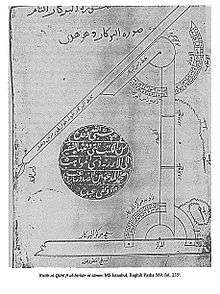Ahmad al-Qalqashandi
Shihab al-Din abu 'l-Abbas Ahmad ben Ali ben Ahmad Abd Allah al-Qalqashandi (1355 or 1356 – 1418) was a medieval Egyptian writer and mathematician.
Born in a village in the Nile Delta, al-Qalqashandi was scribe of the scroll (katib al-darj) in the Mamluk chancery in Cairo. He is the author of Subh al-a 'sha, completed in fourteen volumes in 1412, "one of the final expressions of the genre of Arabic administrative literature".[1]
The Subh al-a 'sha included a section on cryptology. This information was attributed to Ibn al-Durayhim who lived from 1312 to 1361, but whose writings on cryptology have been lost. The list of ciphers in this work included both substitution and transposition, and for the first time, a cipher with multiple substitutions for each plaintext letter. Also traced to Ibn al-Durayhim is an exposition on and worked example of cryptanalysis, including the use of tables of letter frequencies and sets of letters which can not occur together in one word.
References
- ↑ Maaike van Berkel (2009). "al-QALQASHANDĪ". In Roger M. A. Allen; Terri DeYoung. Essays in Arabic Literary Biography II: 1350-1850. Otto Harrassowitz Verlag. pp. 331–40. ISBN 978-3-447-05933-6. Retrieved 30 March 2013.
External links
- Qalqashandī, Aḥmad ibn ʻAlī (1879). Die Geographie und Verwaltung von Ägypten. Translated by Ferdinand Wüstenfeld.
- Qalqashandī, Aḥmad ibn ʻAlī (1903). Ṣuhḥ al-aishā.
| Arabic Wikisource has original text related to this article: |
Further reading
- Christian and Jewish Religious Dignitaries in Mamluk Egypt and Syria: Qalqashandi´s Information on their Hierarchy, Titulature, and Appointment (I &II) International Journal of Middle East Studies, 3:1, 3:2 (1972)
